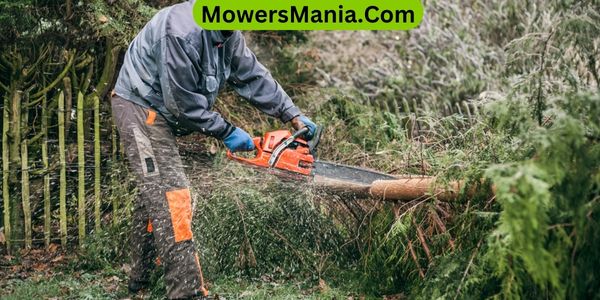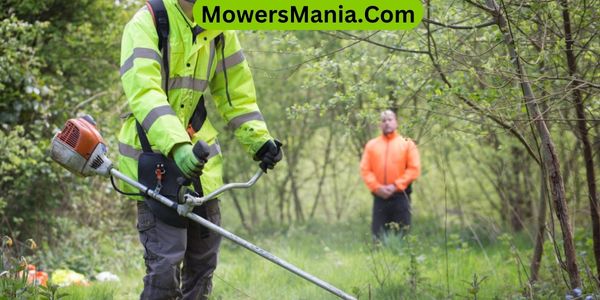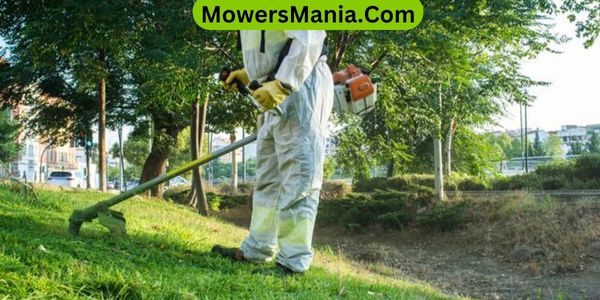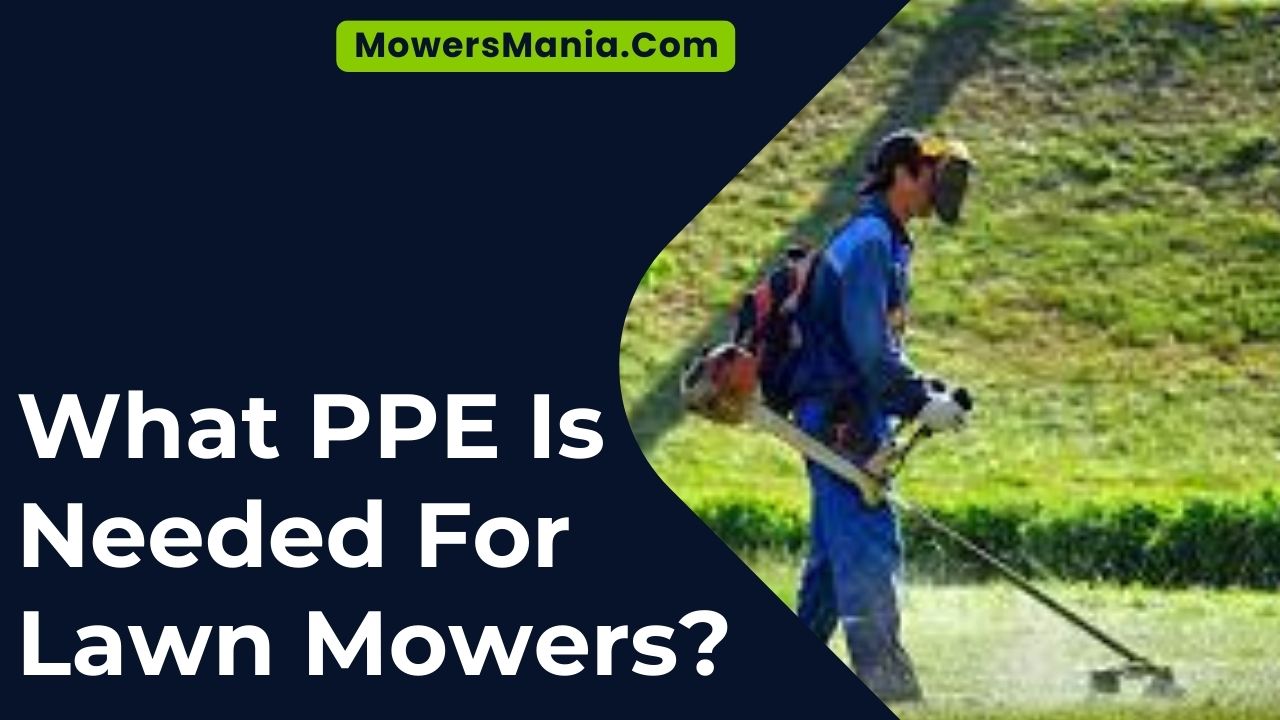When you start up your lawn mower and begin cutting the grass, do you ever think about the potential hazards to your eyes, ears, and hands?
Many people overlook the importance of wearing the right personal protective equipment (PPE) when operating a lawn mower.

However, taking the necessary precautions can help prevent serious injuries. Let’s explore the specific PPE needed for lawn mowers and how it can keep you safe while you work in the yard.
Eye Protection
Consider wearing safety goggles or glasses to protect your eyes while operating a lawn mower. It’s crucial to shield your eyes from flying debris such as rocks, sticks, and grass clippings that can cause serious eye injuries.
Safety goggles or glasses with side shields provide the best protection by creating a barrier against objects coming from different angles.
Ensure that the eyewear is ANSI-approved and fits securely on your face to prevent any particles from getting through. Additionally, opt for clear lenses to maintain good visibility while mowing.
When selecting eye protection, prioritize comfort and a snug fit to prevent the goggles or glasses from slipping off during operation. Some models come with adjustable straps or cushioned frames to enhance comfort and stability.
Hearing Protection
When mowing the lawn, it’s essential to protect your ears from the loud noise of the mower.
Noise reduction devices, such as ear muffs or ear plugs, are crucial for maintaining your hearing health.
Understanding the various hearing protection options available will help you choose the best one for your comfort and safety.
Ear Protection Importance
Protect your ears from the loud noise of lawn mowers by wearing proper hearing protection. The noise generated by lawn mowers can reach levels that are harmful to your ears if exposed for prolonged periods.
Here’s a simple guide to help you choose the right hearing protection for mowing the lawn:
| Type of Hearing Protection | Description |
|---|---|
| Ear Muffs | These cover the entire ear and provide a good seal against noise. They are easy to put on and take off. |
| Ear Plugs | These are inserted into the ear canal and come in disposable or reusable forms. They are lightweight and portable. |
| Noise-Canceling Headphones | These use active noise control to reduce the exposure to loud sounds. They are comfortable and offer good noise reduction. |
| Safety Earmuffs | These provide hearing protection along with additional features like built-in communication systems or AM/FM radio. |
Choose the hearing protection that best suits your preferences and ensures the safety of your ears while working with lawn mowers.
Noise Reduction Devices
To safeguard your hearing while operating lawn mowers, it’s crucial to select appropriate noise reduction devices.
The loud noise generated by lawn mowers can cause hearing damage over time, so investing in quality hearing protection is essential.
One of the most common and effective noise reduction devices for lawn mower use is earmuffs. These cover the entire ear and create a seal to block out the noise.
Another option is earplugs, which fit into the ear canal to reduce the amount of sound that reaches your eardrum.
It’s important to choose noise reduction devices that are comfortable to wear for extended periods, as discomfort may lead to inconsistent usage.
Prioritize your hearing health by selecting the right noise reduction devices for your lawn mowing activities.
Hearing Protection Options
Selecting appropriate noise reduction devices for lawn mower use is essential to safeguard your hearing.
When it comes to protecting your ears from the loud noise of a lawn mower, there are several options to consider:
- Earplugs: These small inserts fit into the ear canal to block out noise.
- Earmuffs: These cover the entire ear and provide a more secure fit for some users.
- Electronic earmuffs: These are designed to amplify quiet sounds while blocking out loud noises.
- Noise-cancelling headphones: These use active noise control to reduce the level of outside noise.
- Custom ear protection: For a perfect fit, consider getting custom ear protection from an audiologist.
Choose the option that best suits your comfort and the noise level of your lawn mower.
Footwear

Choosing the right footwear is crucial for ensuring your safety while operating a lawn mower. You need to wear sturdy, closed-toe shoes or boots to protect your feet from flying debris, sharp objects, and potential hazards while mowing. Avoid wearing sandals, flip-flops, or any open-toe shoes as they do not provide adequate protection.
When selecting footwear for mowing, consider options that offer good traction to prevent slipping, especially on uneven or wet terrain.
Additionally, choose footwear that is comfortable and provides good ankle support to reduce the risk of sprains or other injuries while maneuvering the mower.
To emphasize the importance of suitable footwear for mowing safety, consider the following table:
| Footwear Option | Protection Level |
|---|---|
| Sturdy boots | High |
| Closed-toe shoes | Medium |
| Sandals | Low |
| Sneakers | Low |
| Steel-toe boots | High |
Hand Protection
When mowing the lawn, it’s essential to protect your hands with the right gloves. Different materials offer varying levels of protection, so it’s important to consider your needs and the tasks at hand.
Additionally, features like grip-enhancing surfaces can improve your control and reduce fatigue while operating the mower.
Glove Material Options
To ensure adequate hand protection while operating a lawn mower, it’s important to consider the various options for glove materials.
When choosing gloves for lawn mowing, you should take into account the specific features and benefits of different materials.
Here are some options to consider:
- Leather: Offers excellent durability and protection against cuts and abrasions.
- Nitrile: Provides good resistance to punctures and chemicals, suitable for handling fuels and oils.
- Neoprene: Offers protection against chemicals, oils, and solvents, and provides a good grip.
- Cotton: Lightweight and breathable option for general protection against blisters and abrasions.
- Synthetic Leather: Combines the durability of leather with the flexibility and comfort of synthetic materials.
Carefully selecting the right glove material can significantly reduce the risk of hand injuries while using a lawn mower.
Proper Glove Fit
After considering the various options for glove materials, ensuring a proper fit for your gloves is crucial for providing effective hand protection while operating a lawn mower.
Ill-fitting gloves can cause discomfort, reduce dexterity, and compromise safety. To ensure the right fit, measure your hand’s circumference around the knuckles and hand length.
Choose gloves that are snug but not too tight, allowing for comfortable movement without slipping. The fingertips should reach the end of the glove without excessive bunching.
Check for any gaps or excess material around the palm and wrist area. Make sure the gloves don’t interfere with the operation of the lawn mower’s controls.
Proper glove fit is essential for maintaining a secure grip, preventing blisters, and safeguarding your hands from potential hazards.
Grip-Enhancing Features
Consider selecting gloves with grip-enhancing features, such as textured palms or fingers, to improve your control and stability while operating a lawn mower.
These features can help reduce the risk of slipping and losing control of the mower, especially when dealing with uneven terrain or wet grass.
When choosing gloves with grip-enhancing features, keep in mind the following:
- Look for gloves with rubberized or silicone patterns on the palms for enhanced traction.
- Consider gloves with reinforced fingertips to provide a better grip on the mower’s handles.
- Opt for gloves with adjustable wrist closures to ensure a secure and comfortable fit.
- Choose gloves with breathable materials to prevent your hands from getting sweaty and slippery.
- Consider gloves with padded palms to reduce vibrations and provide extra cushioning for long mowing sessions.
Clothing
Wear durable, close-fitting clothing when operating a lawn mower to reduce the risk of injury from debris. Loose clothing or dangling accessories can get caught in the mower’s moving parts, leading to serious accidents.
Opt for long pants and a long-sleeved shirt to provide an additional barrier of protection against flying debris.
Avoid wearing jewelry, especially necklaces, bracelets, or rings, as they can easily get entangled. Additionally, choose sturdy, closed-toe shoes to shield your feet from any objects that might be flung by the mower.
It’s essential to select clothing made from tough, thick materials that can withstand potential contact with debris. Avoid lightweight or delicate fabrics that can easily tear or get punctured.
Consider wearing work overalls or coveralls for extra protection. Remember to tuck in your shirt and secure any loose ends to prevent them from getting caught in the mower.
Respiratory Protection

To safeguard yourself while operating a lawn mower, prioritize respiratory protection by wearing a dust mask or respirator to prevent inhalation of airborne debris and grass clippings.
When it comes to respiratory protection, consider the following:
- N95 Dust Mask: A disposable N95 dust mask can effectively filter out small particles, providing protection against grass clippings and other airborne debris.
- Half-Face Respirator: This reusable option offers a more secure fit and better protection compared to a standard dust mask. It also allows for the use of replaceable filters.
- Full-Face Respirator: For comprehensive protection, especially when dealing with larger mowing tasks, a full-face respirator with integrated eye protection is ideal.
- P100 Filters: When using a respirator, opt for P100 filters as they’re highly efficient at filtering out both oil-based and non-oil-based particles.
- Proper Fit: Regardless of the type of respiratory protection chosen, ensure it fits snugly over your nose and mouth to prevent any gaps that may allow particles to enter.
Frequently Asked Questions [FAQs]
What Are the Best Practices for Maintaining and Storing PPE for Lawn Mowing Equipment?
When maintaining and storing PPE for lawn mowing equipment, ensure proper cleaning and storage to prolong its effectiveness. Regularly inspect for wear and tear, and replace any damaged items. Store in a cool, dry place to prevent deterioration.
Are There Any Specific PPE Requirements for Individuals With Allergies or Sensitivities to Certain Materials?
If you have allergies or sensitivities to certain materials, it’s essential to identify the specific triggers and then select PPE made from alternative materials. Always prioritize your safety and comfort by choosing suitable PPE.
How Can PPE Help Prevent Accidents and Injuries While Using Lawn Mowers?
To prevent accidents and injuries while using lawn mowers, wear PPE like eye protection, earplugs, gloves, and sturdy footwear. These items shield you from flying debris, loud noise, and potential cuts or burns. Stay safe and protected.
Are There Any Regulations or Guidelines for Using PPE When Operating Lawn Mowers in Different Environments or Weather Conditions?
When operating lawn mowers in different environments or weather conditions, always follow regulations and guidelines for using PPE. It’s crucial for your safety and protection, so make sure you have the right gear for the job.
What Are the Potential Risks of Not Using the Recommended PPE While Operating Lawn Mowers?
If you don’t use the recommended PPE while operating lawn mowers, you risk getting injured by flying debris, sharp objects, or chemical exposure. Not wearing proper protection can lead to serious accidents and potential long-term health issues.
Conclusion
So, when using a lawn mower, remember to always wear the necessary PPE to protect yourself from potential hazards.
This includes eye and hearing protection, sturdy footwear, gloves, and appropriate clothing.
Don’t forget about respiratory protection if you’re working in dusty or grassy areas.
Stay safe and enjoy your time in the yard!



